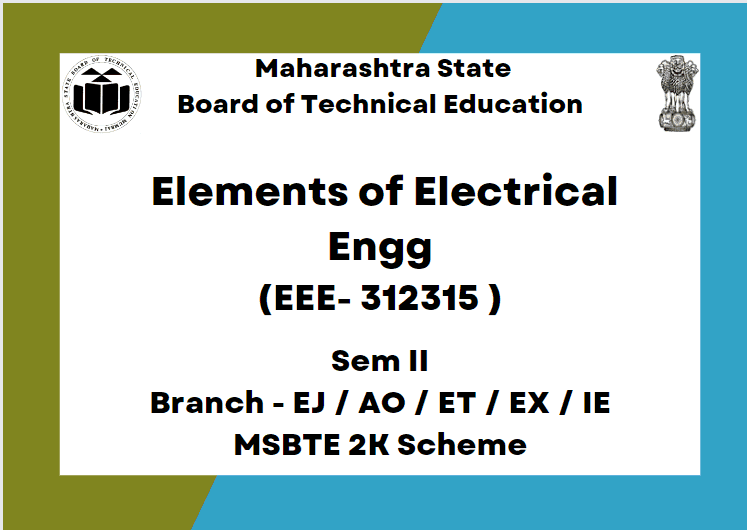Elements of Electrical Engg (EEE- 312315) Sem II MSBTE K Scheme for EJ / AO/ DE/ EJ/ ET/ EX/ IC/ IE/ IS/ MU/ TE
This blog on “Elements of Electrical Engg (EEE- 312315)” will provide all the required study materials, including the syllabus, sample MSBTE question papers, MSBTE paper solutions, and unit-by-unit questions and answers with marks in accordance with the MSBTE’s “K” scheme. If you are looking for study material that will help you pass with good marks in “Elements of Electrical Engg (EEE- 312315)” then this is the perfect blog for you, and your search will end here.

“Elements of Electrical Engg (EEE- 312315)” is for the second semester of MSBTE K scheme Diploma in Automation and Robotics/ Digital Electronics/ Electronics & Tele-communication Engg./ Electronics & Communication Engg./ Electronics Engineering/ Instrumentation & Control/ Industrial Electronics/
Instrumentation/ Medical Electronics/ Electronics & Computer Engg.
A technical person has to deal with the various electrical machines, equipment, and protective devices. In order to increase the technical proficiency, a technician should possess essential knowledge of electrical engineering parameters, basic concepts, and laws of electrical engineering. The industry expected outcome is to use electrical equipment efficiently for different electronic engineering application.
Elements of Electrical Engg (EEE- 312315) Syllabus Download for Diploma MSBTE K scheme
Click below to download Elements of Electrical Engineering (EEE- 312315) Syllabus for Diploma in Diploma MSBTE K scheme

Unit wise MSBTE K Scheme board asked important questions
Unit – I Magnetic circuits (Marks – 12)
1.1 Define and state units of Magnetic flux, Flux density, Magnetomotive force, Magnetic field strength,
Permeability.
1.2 Electric circuit and magnetic circuit analogy and differences.
1.3 Series and parallel magnetic circuit.
1.4 Faraday’s laws of electro-magnetic induction, Lenz’s law, Fleming right hand and left hand rule.
1.5 Dynamically and statically induced emf, self and mutual induced Electromotive force and its inductances.
Download Unit I MSBTE Board-Asked Important Questions:

Unit – II A.C fundamentals for single phase and polyphase circuits (Marks – 18)
2.1 Define A.C. and D.C. quantities, advantages of A.C over DC.
2.2 Single phase sinusoidal A.C. wave: instantaneous value, cycle, amplitude, time period, frequency, angular frequency, R.M.S. value, average value for sinusoidal waveform.
2.3 Vector, polar and complex forms representation of an ac quantity, phase angle, phase difference concept of lagging and leading.
2.4 A.C through pure resistance, inductance and capacitance. Its equation, vector diagram and waveform.
2.5 Define polyphase system and advantages of three phase system over single phase system.
2.6 Generation of three phase induced emf and its waveform.
2.7 Phase and line currents, phase and line voltages in star connected and delta connected balanced load system.
Download Unit II MSBTE Board-Asked Important Questions:

Unit – III Transformers and DC motors (Marks – 14 )
3.1 Transformer construction and working principle, emf equation, voltage ratio, transformation ratio.
3.2 Auto-transformer, Pulse transformer and Isolation transformer construction, working principle and
applications.
3.3 DC motor construction and working principle.
3.4 Different types of DC motors with its schematic diagram.
3.5 Applications of DC motors.
Download Unit III MSBTE Board-Asked Important Questions:

Unit – IV Fractional horse power motors (Marks – 12 )
4.1 Construction, working principle and application of split phase single phase AC induction motors.
4.2 Construction, working principle and application of universal motor and reversal of direction of rotation.
4.3 Construction, working principle and application of stepper motor. Only concept of speed control, stepper motor’s reversal of direction of rotation
4.4 Construction, working principle, specification and application of linear induction motor
Download Unit IV MSBTE Board-Asked Important Questions:

Unit – V Electrical protective devices (Marks – 12 )
5.1 Electrical general safety rules, Personal Protective Equipment (PPE), Selection of wires and cable as per
application.
5.2 Type of fuses, operation, connection diagram and application of fuses, Miniature Circuit Breaker(MCB),
Moulded Case Circuit Breaker (MCCB), Earth Leakage Circuit Breaker(ELCB)operation, connection diagram and general specification
5.3 Draw circuit connection diagram of Protective devices.
5.4 Need of Earthing, methods of earthing, types of earthing and factors affecting earthing as per Indian
Electricity rule.
Download Unit V MSBTE Board-Asked Important Questions:

Which subjects are in the second semester of the E&TC engineering (EJ) diploma?
Following are the four theory exam subjects for the E&TC engineering diploma:
1. APPLIED MATHEMATICS (AMS)
2. BASIC ELECTRONICS (BEL)
3. ELECTRONIC MATERIALS & COMPONENTS (EMC)
4. ELEMENTS OF ELECTRICAL ENGINEERING (EEE)
Practical-oriented subjects are :
1. PROGRAMMING IN ‘C’ LANGUAGE (CPR)
2. ELECTRONICS WORKSHOP PRACTICE (EWP)

[…] https://shikshamentor.com/elements-of-electrical-engg-sem-ii-msbte-k-scheme/ […]
[…] https://shikshamentor.com/elements-of-electrical-engg-sem-ii-msbte-k-scheme/ […]
[…] https://shikshamentor.com/elements-of-electrical-engg-sem-ii-msbte-k-scheme/ […]